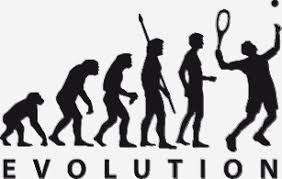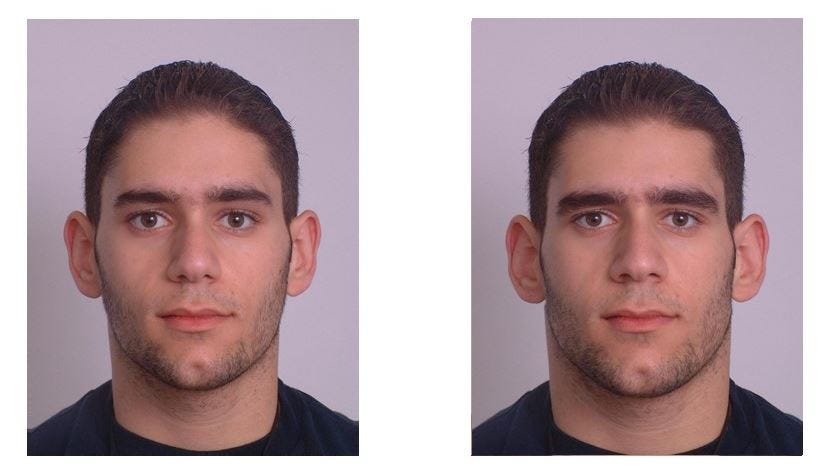This is a guest post by Mitch Brown, who is faculty at University of Arkansas in the Department of Psychological Science. His research primarily considers the interplay between fundamental social motives in shaping social perceptions. More recent investigations considered the perceived advantages and disadvantages of formidable men in group living and parenting. His work has recently been published in Evolution and Human Behavior, Emotion, and Personality and Individual Differences.
You can find more of Mitch on The Dissenter’s excellent1 podcast:
The research was conducted in collaboration with Marie Roweton.
An extensive evolutionary history has led humans to develop some fairly accurate first impressions of other people from their appearance. Although these inferences could be uncomfortable to some perceivers, an acuity to such kernels of truth could have a benefit to the perceiver. Natural selection would have favored people who could accurately identify individuals who could help keep them safe or provide a chance to reproduce. If someone appears capable of helping you reach your goal, you will feel compelled to approach them. If someone looks like a hindrance to your goals, you may avoid that person at all costs. In my work, we consider facial features that are relatively diagnostic of people’s physical capabilities in combat and how they lead people to consider the pros and cons of a potential bodyguard. Namely, we are interested in how perceivers infer men’s physical strength through these features and the contexts in which choosing to affiliate with these men would be advantageous or a complete disaster.

One physical characteristic of a person that reliably connotes information about one’s physical abilities is sexual dimorphism. Dimorphism refers to the extent to which men appear masculine and women appear feminine through facial and bodily features connoting specific hormonal activities. Testosterone masculinizes facial structures, with men’s faces being particularly wider than women’s, in addition to fostering a “stronger” jawline. Conversely, estrogen feminizes faces, with particularly feminine-appearing women having larger eyes and narrower jawlines. Awareness of these features could help people identify attractive mates while similarly helping perceivers stay aware of the potential costs of individuals with sex-typical features (e.g., masculine men appear more aggressive). In addition to these connotations of good genes is the possibility that people can use these features as heuristics to categorize others into political groups. Other work that we have conducted indicates that people use masculinized features in men as a heuristic for their political affiliation. Strong men appear more conservative, which tracks strong men’s actual political beliefs.
These implicit connections between masculinization and conservatism could implicate masculinized men as presenting a heuristic threat to non-conservatives in their attainment of group goals. One such group that has received considerable interest over the past decade relevant to this potential threat judgment is left-wing authoritarianism (LWA), a personality trait indicating the extent to which an individual is interested in disrupting present social hierarchies in favor of one that could better satisfy the goals of left-wing political ideas. In the case of left-wing authoritarians, such goals could include the implementation of redistributive policies as replacements for social policies that emphasize competitive resource acquisition and favor formidable men. The physical advantages that masculinized men would have in conflict would implicate them as especially threatening to the resource acquisition goals of left-wing authoritarians, which could lead to this ideology motivating individuals to dissociate with people who are both dissimilar to them politically and capable of commanding more social capital through competition. Paradoxically, this aversion would be at the expense of having access to potential allies in other kinds of conflict that could see cooperation between strange bedfellows.
We conducted a study that considered these possibilities, presented at the Social Science Speakeasy/First SOIBS Conference in Atlanta during SPSP in February. Participants viewed a series of men and women who varied in their appearance and evaluated their fighting ability, political orientation, and the extent to which they would like to collaborate with each individual person on a project. Importantly, these faces were manipulated to exhibit either masculine or feminine dimensions (i.e., sex typicality) based on widely used transformational procedures to create images of what is typical for both sexes. We also assessed individual differences in LWA using a recent (and amazing!) personality inventory.

Unsurprisingly, male faces appeared more formidable, particularly when they were masculinized. This perception corresponded with inferences of masculinized men appearing more conservative. Although LWA had no influence on preferences for female faces, LWA predicted how perceivers would interface with male faces. The data indicated a general pattern of misandry as a function of heightened LWA, but the magnitude of effects was much larger masculinized male faces. In other words, left-wing authoritarians disliked masculine men.
The data speak to a relative conflict between evolved and modern motives that could inform people’s predilections for both team-building and ingroup favoritism. On one hand, strong men can afford protection from threats and enforce group rules to keep everyone happy. On the other hand, these men appear likely more interested in maintaining social structures that favor competitive hierarchies that leftists oppose. It could be the case that this personality trait is especially salient in the current polarized sociopolitical landscape, with individuals feeling the need to engage in contrarianism to assert their social identity as status quo up-enders. It could also be the case that conducting this research with young adults could have made these effects emerge more easily, given that many of my participants were likely in a developmental stage that motivates certain aspects of political activism.
As I move forward with this research, I am becoming particularly interested in how I can reduce prejudice toward physical differences oftentimes overlooked in prevalent models of behavioral sciences that are no less informative to social perceptions, particularly those with meaningful consequences (i.e., health disparities in men). The benefits of formidable allies are likely apparent to perceivers, but the costs may have greater salience unless they are forced to make difficult choices. Are there any social roles theorists in the foxholes of ancestral necessity? It’s an empirical question that we are all too eager to answer!






I just found this. I lean left but I'm no LWA, not by a long shot. I can offer one reason why some liberals in general might avoid or be wary of masculine-looking men: Potential for an abusive personality. I've always been quite wary of very muscular, masculine looking- and -acting men. They're hot, for sure, but I tended to stay away from them when i was younger. I figured out early on that overt masculinity, and esp hyper-masculinity, tended to hide personalities that could be inclined toward partner violence. I knew that didn't mean they WERE prone to abuse, but I learned early on to screen men via masculinity or 'bro' culture', including certain professions, pasttimes, cultures and religions. (About 15 years ago I was on a coffee date with someone and dismayed to hear him say he was into boxing - not watching, doing). My warning bells went off. Then he went on to act like an idiot so it was easy to drop him). I can't speak for LWAs, but I caution *all* women to screen heavily the more-masculine men. Some of them are awesome wonderful people. You just have to be careful.
It's only recently that the parties have become polarized by sex. I wonder how this has affected the results, and if they would have been different back when right and left didn't correspond to male and female.